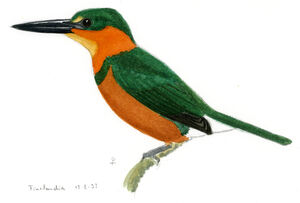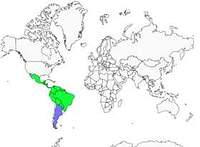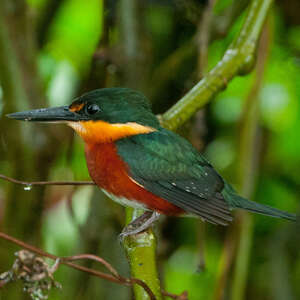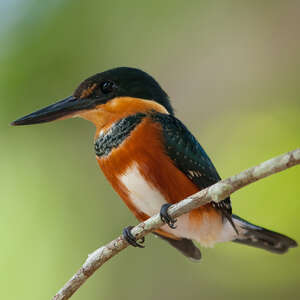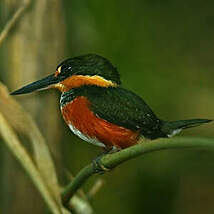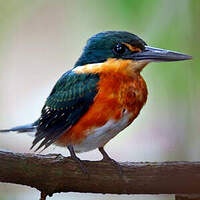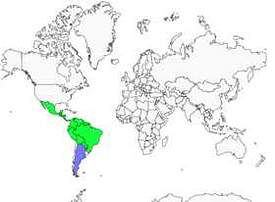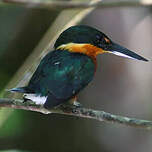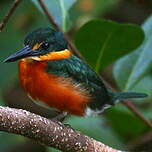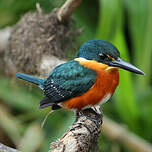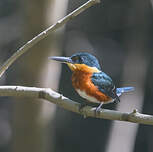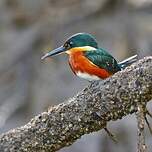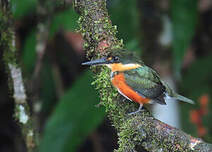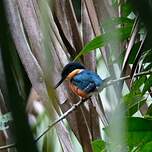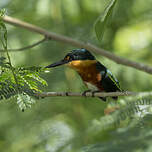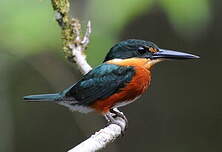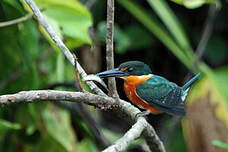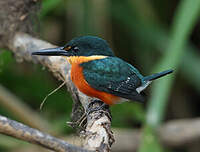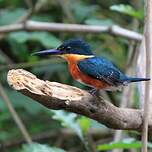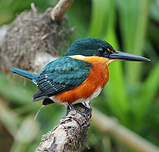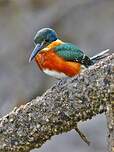American Pygmy Kingfisher
Chloroceryle aenea - Martin-pêcheur nain
Identification
Subspecific information 2 subspecies
- Chloroceryle aenea aenea (c Costa Rica to n Bolivia, Paraguay, sc Brazil and n Argentina)
- Chloroceryle aenea stictoptera (s Mexico to c Costa Rica)
Foreign names
- Martin-pêcheur nain,
- Martín pescador enano,
- martim-pescador-miúdo,
- Erzfischer,
- amerikai törpejégmadár,
- Groene Dwergijsvogel,
- Martin pescatore pigmeo americano,
- bronskungsfiskare,
- Bronseisfugl,
- rybárec malý,
- rybařík kovový,
- Dværgstødfisker,
- pikkuviherkalastaja,
- alció verd pigmeu,
- rybaczek mały,
- pritlikavi pasat,
- Карликовый зелёный зимородок,
- コミドリヤマセミ,
- 侏绿鱼狗,
- bronskungsfiskare,
- 侏綠魚狗,
Habitat
Forest : Subtropical/Tropical Moist Lowland, Subtropical/Tropical Mangrove Vegetation Above High Tide Level, Subtropical/Tropical Moist Montane ; Wetlands (inland) : Permanent Rivers/Streams/Creeks (includes waterfalls), Bogs, Marshes, Swamps, Fens, Peatlands, Permanent Freshwater Lakes (over 8ha) ; Marine Intertidal : Rocky Shoreline, Sandy Shoreline and/or Beaches, Sand Bars, Spits, Etc, Shingle and/or Pebble Shoreline and/or Beaches ; Artificial/Terrestrial : Plantations
Threats - protection
IUCN conservation status
Extinct
Threatened
Least
concern
concern
Extinc
in the Wild
in the Wild
Near
threatened
threatened
Not
evaluated
evaluated
EX
EW
CR
EN
VU
NT
LC
NE
Sources of information
- IOC World Bird List (v15.1), Gill, F and D Donsker (Eds). 2025-12-07.
Other sources of interest
- Accipitriformes
- Aegotheliformes
- Anseriformes
- Apodiformes
- Apterygiformes
- Bucerotiformes
- Caprimulgiformes
- Cariamiformes
- Casuariiformes
- Charadriiformes
- Ciconiiformes
- Coliiformes
- Columbiformes
- Coraciiformes
- Cuculiformes
- Eurypygiformes
- Falconiformes
- Galliformes
- Gaviiformes
- Gruiformes
- Leptosomiformes
- Mesitornithiformes
- Musophagiformes
- Nyctibiiformes
- Opisthocomiformes
- Otidiformes
- Passeriformes
- Pelecaniformes
- Phaethontiformes
- Phoenicopteriformes
- Piciformes
- Podargiformes
- Podicipediformes
- Procellariiformes
- Psittaciformes
- Pterocliformes
- Rheiformes
- Sphenisciformes
- Steatornithiformes
- Strigiformes
- Struthioniformes
- Suliformes
- Tinamiformes
- Trogoniformes

